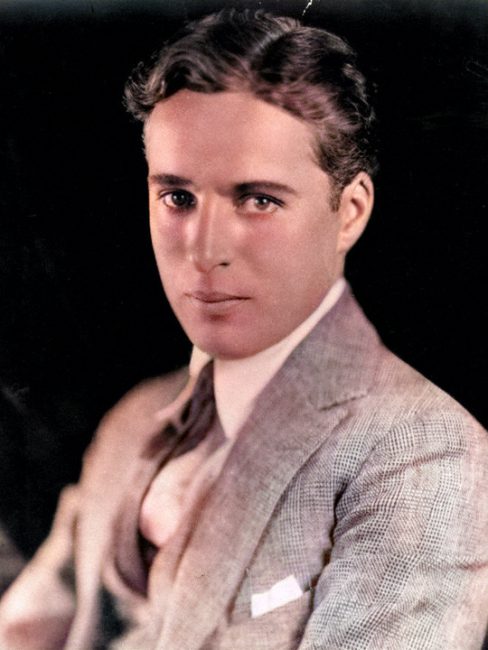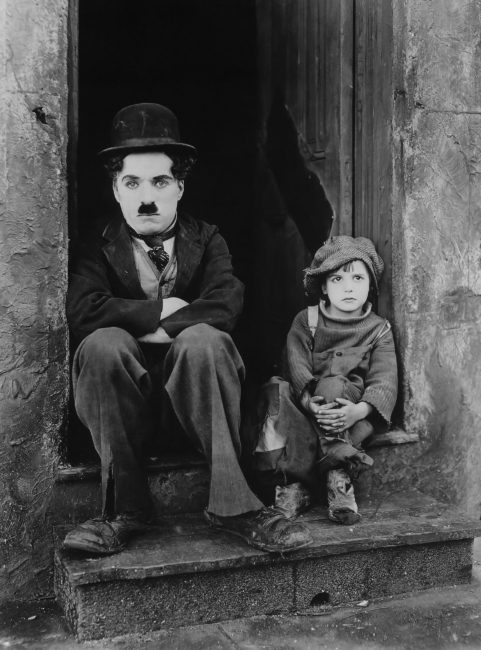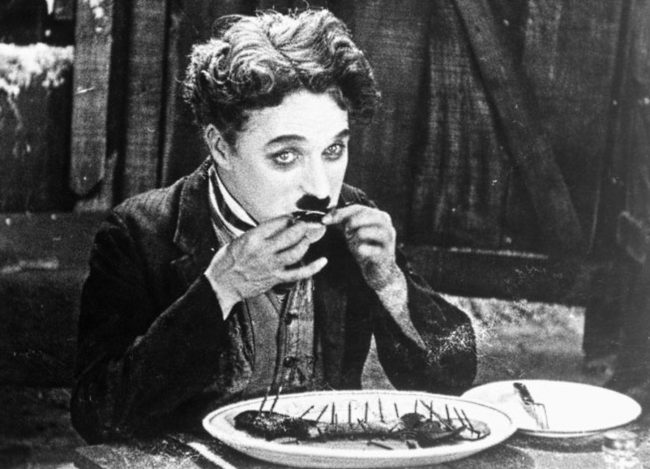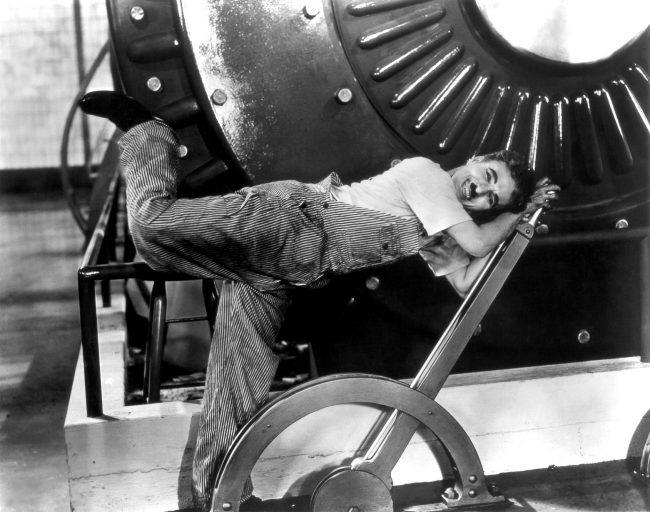
Charlie Chaplin (1889-1971)
On April 16, 1889, English comic actor, filmmaker, and composer Sir Charles Spencer Chaplin was born. He rose to fame in the era of silent film and became a worldwide icon through his screen persona, The Tramp. Chaplin is considered one of the most important figures in the history of the film industry. His career spanned more than 75 years and encompassed both adulation and controversy.
“Wars, conflict, it’s all business. “One murder makes a villain. Millions a hero”. Numbers sanctify.”
– Charles Chaplin, in Monsieur Verdoux (1947)
Charlie Chaplin Family Background and London Years
Charles Chaplin was born in London, the son of Charles Chaplin Sr. (1863-1901) and Hannah Harriet Chaplin (1865-1928). Both were performers at British music halls, the father a singer and entertainer, the mother a dancer and singer. Shortly after Charles’ birth, his parents separated. Charles and his half-brother Sydney (1885-1965), who was four years older, grew up with their mother, who was unable to pursue her profession from 1896 because of mental problems. Since Chaplin Sr. regularly evaded alimony payments, the family lived in great poverty and repeatedly had to seek refuge in the poorhouses of London. Chaplin first got the chance to perform in front of an audience himself with a vocal performance in 1894. At the age of nine, on his father’s recommendation, he was hired to perform with the music hall group The Eight Lancashire Lads. Chaplin received room and board and a basic education while touring with the Lancashire Lads. When his father died in 1901 as a result of his alcoholism, Sydney now provided for the upkeep of his brother and mother, who was admitted to lunatic asylums several times and declared insane in 1905. Chaplin was almost entirely on his own, was first put in an orphanage with his half-brother when he was six years old, and later prowled the streets and became acquainted with the lowest social milieu, which he observed closely. He left school for good at the age of 13. He worked as an errand boy, newspaper vendor, printer, toy maker and glass blower to make a living.
Enter the Stage
In the summer of 1903, he played his first major role in the less successful play Jim, A Romance of Cockayne. This was followed by the role of Billy the errand boy in the stage version of Sherlock Holmes written by William Gillette. This production was a great success. With Fred Karno, who continued the tradition of comic pantomime plays with his theater troupes, Chaplin quickly rose to become one of the leading actors. His first success with Karno was the role of the drunkard Swell in the play Mumming Birds. In 1910 Chaplin took the leading role in the new production Jimmy the Fearless, which earned him positive reviews in the newspapers for the first time. Karno then offered Chaplin the opportunity to tour North America with an ensemble. From June 1910 to June 1912, Karno’s troupe performed throughout the United States and Canada. Chaplin’s escapades in A Night in an English Music Hall, a revival of Mumming Birds, in particular, delighted audiences and the press. There, he also raised the interest of the American film industry. On September 25, 1913, Chaplin finally signed a contract to become a film actor for a year at Mack Sennett‘s Keystone Studios, the comedy division of the New York Motion Picture Company.
Keystone Pictures
“All I need to make a comedy is a park, a policeman and a pretty girl.”
– Charles Chaplin, My Autobiography (1964)
In the first few weeks, he had great difficulty coping with the chaotic working conditions at Keystone. Chaplin was used to months of rehearsal on the sketches from his time at Karno, until every gesture and every punch line was perfect. Mack Sennett, on the other hand, usually worked without a script, and his productions were quickly shot. It was not until the end of the month that Chaplin was used in a film. The one-act Making a Living was directed by Henry Lehrman, who also played the hero of the story.
The Birth of the Tramp
Dissatisfied with this role, Chaplin developed a new character for the following films. According to legend, he borrowed an old pair of shoes from Ford Sterling and oversized pants from Roscoe “Fatty” Arbuckle, a bowler hat from Arbuckle’s father-in-law, a too-small jacket from Charles Avery, and the fake beard from Mack Swain. The “Tramp” first appeared in early February 1914 in the films Kid Auto Races at Venice and Mabel’s Strange Predicament. After Chaplin failed to get along with either Henry Lehrman or George Nichols, Sennett tried to use Chaplin in the films directed by Mabel Normand. When there was an altercation between him and Normand during the shooting of Mabel at the Wheel, Chaplin already believed that his days at Keystone were numbered. But the great demand for films with Chaplin forced Sennett to continue to give him a free hand. Chaplin was to direct a film on a trial basis. His directorial debut, Caught in the Rain, was released on May 4, 1914, and went on to become one of Keystone’s most successful films to date. Given his rapidly increasing market value, Chaplin demanded $1,000 per week from Sennett if the contract continued. No agreement was reached, however, and Chaplin’s engagement with Keystone ended at the end of 1914 after 35 films.
At Essanay
The celebrated silent film comedian later wrapped up the mystery of the recipe for success to his Tramp character in simple words: “All my films are built on the idea of getting myself into trouble so that afterwards I can make a desperately earnest effort to appear as a normal little gentleman.” At least after a bumpy start to his career, Chaplin, in his role, was always perceived as the good guy, the nice guy, the little guy, who nevertheless didn’t let it get him down and ended up with nothing but his dignity. In November 1914, Charles Chaplin signed a contract with Essanay, the film company run by film pioneers George K. Spoor and Gilbert M. Anderson, which guaranteed Chaplin a one-time payment of $10,000 in addition to a weekly fee of $1250. Chaplin made his first film, His New Job, in January 1915 at the outdated Essanay studios in Chicago, but then moved back to California. There he assembled his own regular cast, which included Leo White, Billy Armstrong, Bud Jamison, John Rand and future director Lloyd Bacon. In his search for a female lead, Chaplin discovered 19-year-old Edna Purviance, who eventually starred in 35 of his films and with whom he also had a private relationship until 1917. Chaplin increasingly settled on the role of the vagabond, who even became the title character in his sixth Essanay film The Tramp. While slapstick predominated in Chaplin’s early films, romantic elements emerged in A Jitney Elopement and The Tramp, which even led to a sad ending in The Bank.
At Mutual
Chaplin also became the focus of extensive marketing that included Chaplin dolls, newspaper comics, and songs about the Little Tramp. The new contract with Mutual Films, which guaranteed him a weekly salary of $10,000 plus a $150,000 signing bonus, made Chaplin one of the highest paid actors. A new studio was set up for Chaplin in Los Angeles. Chaplin’s contract with Mutual called for twelve films to be produced within twelve months. Some of the Mutual films are considered Chaplin’s best films today. While Chaplin again demonstrated the comic potential of unusual settings with the roller rink in The Rink and an escalator in The Floorwalker, The Pawnshop is considered a prime example of Chaplin’s “comedy of transposition,” in which objects take on an entirely new function. His best-known films from his time at Mutual are the two-act Easy Street, a parody of Victorian reformatory melodramas, completed in 1917, and the tragicomedy The Immigrant. Chaplin, in retrospect, described this period as the happiest in his entire career.
At First National
“Life is a tragedy when seen in close-up, but a comedy in long-shot.”
– Charles Chaplin, as quoted in his obituary in The Guardian (28 December 1977)
After the expiration of the contract with Mutual, Charles Chaplin was looking for a new partner who would allow him not only the financial but also the temporal independence to complete his films. He signed contract with First National for eight films for more than a million dollars in advance. Chaplin became his own producer, retained the rights to his films and had a studio built in Hollywood according to his own ideas. On January 15, 1918, filming began on A Dog’s Life. Immediately after its completion, the filmmaker went on a tour of the United States with Douglas Fairbanks and Mary Pickford to promote the purchase of war bonds. Chaplin’s next film would go on to have World War I as its theme: Shoulder Arms was made, which became one of the biggest financial successes of his career. Privately, Chaplin was less fortunate. At the beginning of 1918, he met the actress Mildred Harris, just 16 years old, with whom he entered into a scandalous relationship. Chaplin and Harris married on September 23, 1918. The unhappy course of the marriage paralyzed Chaplin’s creative energy. Chaplin’s creative crisis ended when he discovered four-year-old Jackie Coogan in a theater. Full of zeal, Chaplin continued work on the film with Jackie Coogan, which had now received its definitive title, The Kid. Totally immersed in work, Chaplin was surprised by his wife’s divorce complaint. Since Mildred refused a settlement of $100,000, the film, finally completed after a year, was threatened with seizure. However, The Kid finally premiered on January 6, 1921. Chaplin’s first feature-length film became a runaway success, distributed in some 50 countries over the next three years.

Publicity photo from Charlie Chaplin’s 1921 film The Kid, featuring Charlie Chaplin (left) and Jackie Coogan (right).
Since First National had shown little cooperation in paying for The Kid, Chaplin wanted to fulfill his contractual obligations as quickly as possible, especially since he now owned his own film distribution company as a co-founder of United Artists. Within five months, the two-act The Idle Class was made. The shooting of the next film, Pay Day, was to be his last two-act play. Pay Day premiered on April 2, 1922. Chaplin’s last film for First National, the four-act The Pilgrim, was completed in only 42 days of shooting. However, renewed disputes with First National over marketing delayed the premiere until February 1923.
United Artists
After his contract with the First National had expired, Chaplin was finally able to prepare his first contribution for United Artists. As early as January 1919, Chaplin, the actors Douglas Fairbanks and Mary Pickford, and the director D. W. Griffith [8] decided to found an independent film distributor in order to counteract a threatening monopoly of the established studios. On February 5, 1919, the contracts for the founding of United Artists were signed. With his first project for United Artists, Chaplin fulfilled his long-held desire to make a serious dramatic film. His acquaintance with Peggy Hopkins Joyce, who became famous for her numerous marriages and love affairs, inspired Chaplin to write the story of the love drama A Woman of Paris, which he shot from November 1922 to June 1923, starring Edna Purviance and Adolphe Menjou. The premiere was celebrated by critics; the restrained, subtle acting of the protagonists, painstakingly devised by Chaplin, was glorified as a “departure from previous screen habits” and thus became the model for numerous directors of the late 1920s. Audiences, however, could not take kindly to Chaplin’s atypical melodrama. A Woman of Paris became his first flop. To avert a major social scandal, in 1924 he married sixteen-year-old Lita Grey, who was slated to be his film partner in his next production, The Gold Rush. The tragicomedy about the hardships of gold seekers in pursuit of wealth, became one of Chaplin’s greatest successes in 1925, and he himself said “with this film I want to be remembered.” In 1928 Chaplin shot the comedy The Circus, which is considered a minor classic in his oeuvre. The filming of The Circus was overshadowed by numerous problems.

Cropped publicity still for Charlie Chaplin’s 1925 film The Gold Rush
City Lights and Modern Times
The end of the 1920s saw the end of silent movies in Hollywood, plus the consequences of the Great Depression. This led to drastic changes in Hollywood, for example, many other slapstick comedians were suddenly no longer in demand. Despite warnings from his colleagues, Chaplin made another silent film, City Lights, in 1931, because in his opinion the Tramp could only work in a silent film. The film was not entirely silent, however; there was a musical soundtrack that Chaplin composed himself, which meant that he now also became the composer of his films for the first time. Once again Chaplin slipped into the role of the Tramp, who here falls in love with a blind flower girl in an emotionally cold city. The risk paid off and the romantic comedy with socio-critical undertones became a massive success with critics and audiences. Although talkies were now firmly established, Chaplin released another silent film, Modern Times, in 1936. He worked with sound effects, however, partly to parody the popular talkies, which Chaplin was skeptical of. He feared that the Vagabond would lose popularity if he spoke in a certain voice. Only at the end of the film does the Tramp sing a song in a fantasy language, as if to prove that words are not needed to tell a story. Its success at the box office confirmed Chaplin’s preeminence as a film comedian. Because Chaplin criticized the excesses of industrialization and capitalism in Modern Times, conservative circles in the United States accused him of being anti-capitalist and communist. Privately, he was now involved with his film partner Paulette Goddard, whom he secretly married in 1936.

Publicity photo of Charlie Chaplin for the film Modern Times (1936).
The Great Dictator
October 15, 1940 was the premiere of Chaplin’s first sound film, The Great Dictator. Chaplin’s satirical parody of fascism was also symbolically directed against U.S. state power and militarism in general. At first, the U.S. censorship authorities did not want to approve this anti-Hitler film. The film was particularly successful commercially for Chaplin. Famous is Charlie Chaplin’s impassioned speech towards the end of the film, an urgent appeal to the soldiers and to the whole world for democracy, peace and humanity. In the early 1940s, Chaplin had discovered the young actress Joan Barry (1920-2007) and wanted to make a film with her. They began a brief affair with each other. After the relationship ended, Barry showed increasing psychological problems and harassed and threatened Chaplin. After the birth of her child in 1943, she stated that Chaplin was the father and sued him. A blood test argued against his paternity, but Barry’s lawyer was able to convince the court that the tests were doubtful. Chaplin lost the case and had to pay money to Barry and their child. The scandal significantly deteriorated Chaplin’s reputation among the American public. In 1942, the marriage with Paulette Goddard was divorced. Shortly thereafter, Chaplin and Oona O’Neill (1925-1991), daughter of playwright Eugene O’Neill, met. On June 16, 1943, Charlie Chaplin and eighteen-year-old Oona O’Neill were married.
Chaplin’s War on Hollywood
In October 1947 Chaplin had to testify repeatedly before the House Un-American Activities Committee. The head of the FBI J. Edgar Hoover, a fierce opponent of Chaplin, tried to revoke his residence permit. In December 1947, the film star published in the English Sunday newspaper Reynold’s News the article “I declare war on Hollywood and its inhabitants!” Although Chaplin achieved his greatest successes in the United States, he retained his British citizenship. He considered himself a citizen of the world. Charles Chaplin was liberal, critical, and later a pacifist, and thus did not fit the common image the government expected of a movie star. People also took offense at his lifestyle. Chaplin also parodied American society behind the scenes and thus became suspicious of the state apparatus. He was accused of a lack of loyalty to the constitution. On September 17, 1952, Chaplin left the United States for a short visit to England. The occasion was the world premiere of his film Limelight, which was set there. It was the beginning of the McCarthy era, and since the FBI under Hoover suspected him of “un-American activities,” the head of the FBI obtained from the Immigration and Naturalization Service the revocation of Chaplin’s re-entry permit to the United States one day later, on September 18. He moved to Switzerland in December 1952 and settled in the Manoir de Ban estate above Corsier-sur-Vevey on Lake Geneva, which he bought shortly thereafter. His 1928 hand and footprints in front of the TCL Chinese Theatre have been removed. The concrete slab with his prints remains lost to this day. There was controversy over the awarding of a star to Chaplin on the Hollywood Walk of Fame, and for political reasons he was denied this honor until 1972.
Later Years
“I remain just one thing, and one thing only — and that is a clown. It places me on a far higher plane than any politician.”
– Charles Chaplin, as quoted in The Observer (17 June 1960)
In 1957, Chaplin processed the bitter experiences he had had in dealing with the United States in the satire A King in New York. In this film he also denounced the early obscurantism in the USA. Chaplin commented, “America is so terribly grim in spite of all that material prosperity.” The film was not shown in the U.S. until 1973. In 1967, Chaplin made the film A Countess from Hong Kong, in which he himself appeared in a small supporting role as a ship’s steward. The film starred Marlon Brando and Sophia Loren, but received only mixed reviews. Only the film song This Is My Song, composed and written by Chaplin, became an international chart success in the version by Petula Clark. In 1970 he re-released The Circus from 1928 with a newly composed film score partly sung by him, followed in 1971 by The Kid from 1921, also with a new film score and a newly edited version. In 1972 he returned to the United States once again for a short time on the occasion of the awarding of an honorary Oscar. After the completion of A Countess of Hong Kong, Chaplin began to suffer from physical ailments more and more frequently from the late 1960s; his earlier robust health gave way to increasing frailty in recent years. Charlie Chaplin died at home in Corsier-sur-Vevey, Switzerland, on December 25, 1977, at the age of 88.
On the night of March 1 to 2, 1978, Chaplin’s body was stolen from the cemetery in Corsier-sur-Vevey (Switzerland). The perpetrators wanted to extort 600,000 Swiss francs from the surviving relatives. The plan failed, they were caught, and Chaplin’s remains were reburied. Chaplin was one of the founding fathers of the dream factory and also of film comedy in general, but he was not a Hollywood star, as he is often referred to: Hollywood didn’t even exist yet, while he was already a star. In his autobiography, for example, Chaplin strongly distanced himself from the later Hollywood with its studio system. As a filmmaker, artistic independence was especially important to him, something that hardly existed in the studio system.
David Thorburn, 3. Chaplin, Part I (2007), [10]
References and Further Reading:
- [1] David Thorburn, MIT 21L.011 The Film Experience, Fall 2013
- [2] Works by or about Charlie Chaplin at Internet Archive
- [3] The Charlie Chaplin Archive Online catalogue of Chaplin’s professional and personal archives at the Cineteca di Bologna, Italy
- [4] Lynn, Kenneth S. (1997). Charlie Chaplin and His Times. New York: Simon & Schuster.
- [5] Gunning, Tom (1990). “Chaplin and American Culture: The Evolution of a Star Image by Charles J. Maland”. Film Quarterly. 43 (3): 41–43.
- [6] Maland, Charles J. (1989). Chaplin and American Culture. Princeton, NJ: Princeton University Press
- [7] Newspaper clippings about Charlie Chaplin in the 20th Century Press Archives of the ZBW
- [8] D. W. Griffith’s Birth of a Nation, SciHi Blog
- [9] Charlie Chaplin at Wikidata
- [10] David Thorburn, 3. Chaplin, Part I (2007), MIT 21L.011 The Film Experience, Fall 2013, MIT Open CourseWare @ youtube
- [11] Timeline for Charlie Chaplin, via Wikidata





